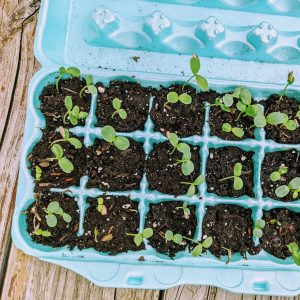Seed Radicle – Understanding the Seed Root
Planting from seed allows you to witness one of nature’s greatest miracles one step at a time. Try my favorite seedling / paper towels germination trick so you can see the seed radicle emerge and grow up close! It’s amazing!
What is a seed radicle?
The radicle is the seed root that emerges from an embryo plant. When you plant a seed in the ground (or in paper towels, etc.), this single root is the first part of the seed that starts growing. The seed radicle is the root that first pushes out of the seed.

Meanwhile, the plumule is the baby stem or shoot that emerges from a plant embryo. This part grows next.
What does the radicle do in a seed?
The radicle digs down into the soil, searching for water it can absorb for the seed. In doing so, this allows the seed to send out its shoot and leaves to begin photosynthesis. (This is the process by which plants use the power of sunlight to synthesize water and carbon dioxide into energy and oxygen.)
Seed Radicle Growth in Plants
The seed root emerges first to get the growth process started. This important part of the plant plays such a meaningful role in plant germination.
Seed radicle growth begins as a single root close to the embryo. Moisture softens the seed coat and that small root pushes through to find more water.
As the radicle absorbs even more water, smaller roots begin to form as well.
Did You Know – Citrus trees are capable of producing multiple seedlings from one seed!
Here, I’ve germinated lemon seeds with three radicles emerging from one seed!

Problems with Seed Roots (Radicle of Seed)
In a perfect world, the seed radicle develops as intended, followed by the baby shoot (plumule) and the leaves until the plant matures and does its thing.
Sometimes, though, seed roots may face problems that may result in seed death.
Too Much Water
If the seed gets too much water, the radicle may begin to rot. Dark spots may develop and the seed roots may begin to decompose. This process where the seed is overwatered generally results in death of the seed embryo.
In some cases, the seed may rot before it emerges from the soil. In other cases, the seed root may become waterlogged after leaves are already growing.
Overwatering creates cool, wet conditions that may invite fungus and mold, which may result in damping off of plants. Through my gardening experiences, I’ve found that watermelons are particularly prone to this.
Too Little Water
Let’s say you plant some seeds and take care of them as intended. Suddenly, life happens and you aren’t able to water them on schedule. If seeds get too little water, those that have already germinated will likely perish.
The radicle of seeds that receive too little water may begin to harden and dry out. If this goes on for too long, your sprouted seeds and seedlings will probably die.

Final Thoughts: The Amazing Seed Radicle
The radicle in plants is a pretty amazing thing! I strongly encourage you to try the paper towel and water germination trick at least once.
It’s really cool to check your seeds daily to see what’s sprouting! Peas can germinate in as little as a day!
Then you’ll get a front-row seat to seeing the radicle of seed growth up close and personal. Kids will especially love this, but I’m not gonna lie – it’s one of my favorite parts of gardening!
Do you have even more knowledge on the seed radicles and seed growth? Please feel free to share in our comments – we value your expertise!
Or, if you have questions we can help with, shout out in the comments, too. We always love hearing from you.
Happy Gardening!







The most efficient way that I have found to germinate seeds is to soak seeds in a mixture of 1 tsp of humic acid to 2 tbls of water for 8-12 hours and then plant the seeds directly into soil. The humic acid begins to soften and break down the seed coat, creating enzymes that start to feed the embryo, which in turn creates the energy needed to begin the first stages of germination. Within 3 days to a week, the radicle will have rooted and the cotyledons will break the surface of the soil.
Hi Magoo, thanks so much for taking the time to leave this helpful and detailed summary of your best success with seed germination! I am not familiar with humic acid and will try to research that and educate myself a bit more. It sounds like a really effective technique! That’s a nice and speedy process to get that far along in a matter of days. Thanks so much for sharing. I’ll try to update the article if I attempt the humic acid over here. Happy Gardening!